Ten Mythical Creatures in Ancient Folklore from Around the World
Mythical creatures, legendary beasts, and supernatural, mystical, and god-like beings have fascinated us since ancient times. They have filled folklore, stories, songs, and works of art. Sometimes living animals or fossils have inspired these mythical creatures. From the powerful dragon to the soaring phoenix, these mythical creatures continue to thrill, terrify, entertain, and inspire us.
Some mythical creatures, such as the Loch Ness Monster or Sasquatch, continue to be spotted and sought out. While the origins of such fabulous creatures are varied, and often disputed, they have played significant roles in human society, serving to stimulate the imagination and desire that is ingrained in human nature to experience more than this physical world. Whether they truly exist in physical form is indeed secondary to their existence in the minds of so many people throughout the world and history.
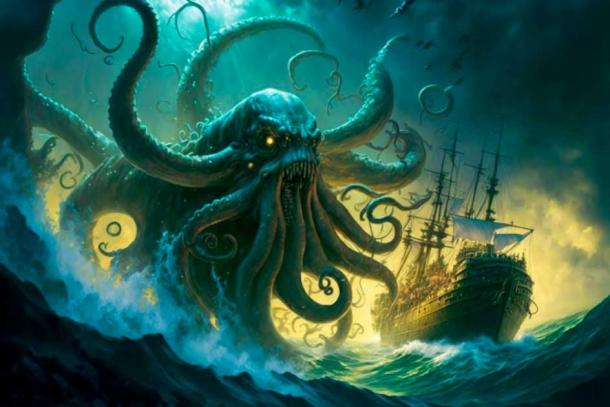
A Kraken, a giant mythical creature from Scandinavian folklore, attacking a ship. (Dieter Holstein / Adobe Stock)
The Legendary Kraken
According to Scandinavian mythology, the Kraken is a giant mythical sea creature, said to be 1 mile (1.61 km) long, that attacks ships and is so huge that its body could be mistaken for an island. It is first mentioned in the Örvar-Oddr, a 13th century Icelandic saga involving two sea monsters, the Hafgufa (sea mist) and the Lyngbakr (heather-back).
The Hafgufa is supposed to be a reference to the Kraken. The existence of the Kraken was even acknowledged in scientific texts, including the first edition of Systema Naturae [1735], a taxonomic classification of living organisms by the Swedish botanist, physician, and zoologist Carolus Linnaeus. Within this scientific work, Linnaeus classified the Kraken as a cephalopod, designating the scientific name Microcosmus marinus.
- Of Monsters and Men: What Is the Grim Being Known as Grendel from the Epic Beowulf?
- Mapping the Menacing Sea Monsters in Medieval and Renaissance Cartography
Although any mention of Kraken was omitted in later editions of the Systema Naturae, Linnaeus described the mythical creature in his later work, Fauna Suecica [1746], as a “unique monster” that “is said to inhabit the seas of Norway.” Accounts of the Kraken are believed by many historians to have originated from sightings of the giant squid, which can reach a staggering 59 feet (18 meters) in length.
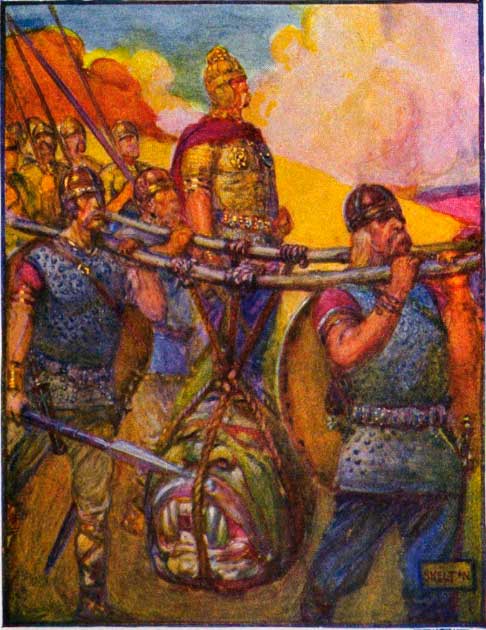
Vikings carrying the head of Grendel, the beast that attacked the feasting hall in Beowulf. (Public domain)
Grendel, the Beast of Hrothgar
Beowulf is an Old English heroic epic poem set in Scandinavia and cited as one of the most important works of Anglo-Saxon literature of all time. Dated between the 8th and early 11th century, the epic poem tells the story of Beowulf, a hero who comes to the aid of Hroðgar, the king of the Danes, by defeating a beast known as Grendel who had been terrorizing the great mead hall built by Hroðgar and threatening the entire kingdom.
Archaeological research has verified that the great hall commissioned by Hroðgar did indeed exist, and was located in the country’s earliest royal capital, Lejre, 23 miles (37.01 km) west of modern Copenhagen. Whether Grendel (meaning quite literally “the destroyer”) originally existed in some less legendary form – perhaps symbolizing a malevolent spirit responsible for disease and death, or a particularly fierce-looking human enemy – is as yet unknown.
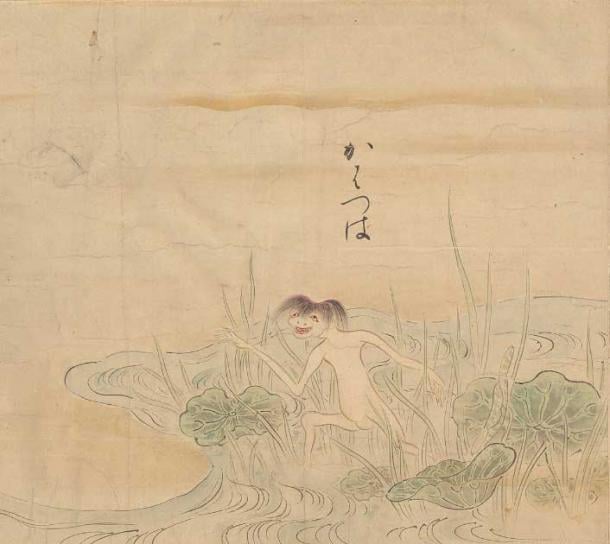
A Kappa water demon as shown in the “Bakemono no e” (meaning “Illustrations of Supernatural Creatures”), a Japanese handscroll depicting mythical creatures from circa 1700. (Brigham Young University / CC BY-SA 4.0)
Kappa, the Japanese Mythical Creature Devouring Disobedient Children
In ancient Japanese folklore, the Kappa is a water demon that inhabits rivers and lakes and devours disobedient little children. The Kappa, a word meaning “river child,” is usually depicted with the body of a tortoise, a beak, and the limbs of a frog, and has a hole filled with water on top of his head. While they are primarily water creatures, they are believed to occasionally venture onto land.
According to legend, the head cavity must be kept wet when the Kappa ventures out of the water, or he will lose his powers. The Kappa is one of the most well-known folk legends in Japan and many believe the mythical creature to be real.
In fact, there are signs near some lakes in Japan warning people of their presence. However, others maintain it is much more likely that the legend of the Kappa is connected with sightings of the Japanese Giant Salamander, or hanzaki, which is known to be aggressive and to grab its prey with its powerful jaws.
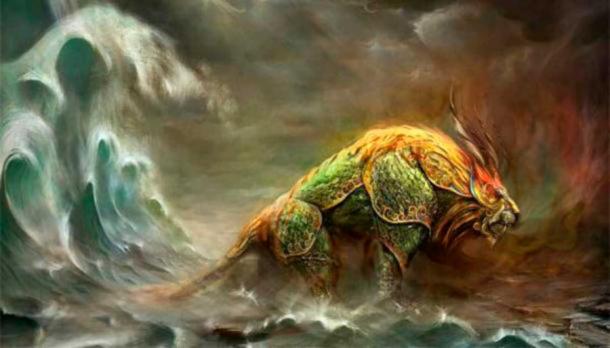
The legendary Nian, one of the mythical creatures of Chinese folklore. (Author supplied)
The Legend of Nian
According to tales and legends, the beginning of Chinese New Year started with the fight against a mythical beast called Nian, which had the body of a bull and the head of a lion. It was said to be a ferocious animal that lived in the mountains and hunted for a living. Towards the end of winter when there was nothing to eat, Nian would come on the first day of New Year to the villages to eat livestock, crops, and even villagers - especially children.
To protect themselves, the villagers would put food in front of their doors at the beginning of every year. It was believed that after the Nian ate the food they prepared, it wouldn’t attack any more people. The villagers would live in terror over the winter, but over time they learned that the ferocious Nian was afraid of three things: the color red, fire, and noise. So, when the New Year was about to come, the villagers would hang red lanterns and red spring scrolls on windows and doors. They also used firecrackers to frighten away the Nian.
From then on, Nian never came to the villages again. According to legend, the mythical creature was eventually captured by Hongjun Laozu, an ancient Taoist monk, and Nian became Hongjun Laozu's mount. After Nian was captured, there were huge celebrations and the ritual involved in banishing him was repeated the following year. These symbolic rituals were passed down from generation to generation and the custom of celebrating the New Year with firecrackers, noise, and the color red has persisted to this day.
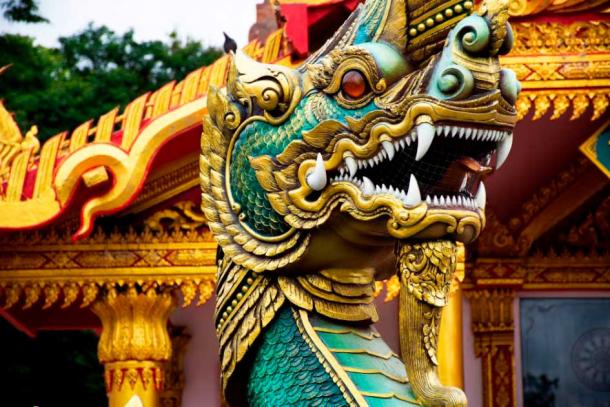
A Naga statue at the Wat Phra Kaew temple in Thailand. (tuayai / Adobe Stock)
Naga, the Water Deity
The Naga is a legendary aquatic, serpentine creature that resides in oceans, rivers, lakes, or waterfalls. Nagas are said to have black scales and can grow to hundreds of feet in length. Nagas are traditionally worshipped as personifications of water deities and considered bringers of rain and clouds.
Nagas are guardians of temples and holy places. Most Kaliyatran believe that the superior God directs the actions of the Nagas, and these sea serpents are honored with many titles such as the Maharaja Sarpa and the “Naga who is God.” It is commonly believed that Nagas live in underground cities, are capable of speech, and can use their heavenly powers to control weather and assume humanoid form at will.
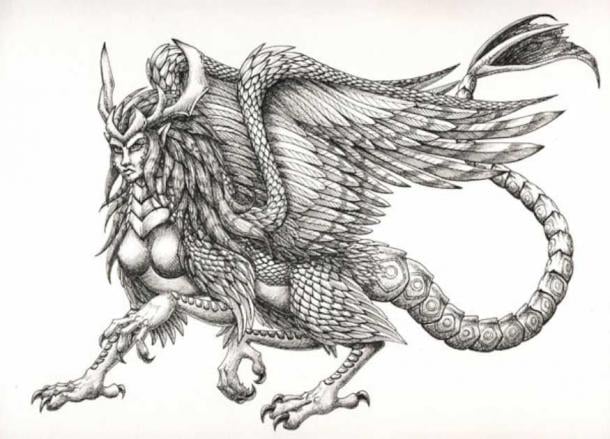
The female Piasa bird, is one of the mythical creatures of Native American mythology. (FoolishLittleMortal)
The Native American Tradition of the Piasa
The legend of the Piasa bird dates back to long before European explorers came to North America. It has been traced to a band of Illiniwek Indians who lived along the Mississippi in the vicinity north of present-day Alton. This tribe, led by a chief named Owatoga, hunted and fished the valley and the river and lived a contented life until the so-called “great beast” came.
The mythical creature Piasa bird was described by French missionary priest Jacques Marquette in 1673 as follows: “it is as large as a calf, with horns like a roebuck, red eyes, a beard like a tiger and a frightful countenance. The face was something like that of a man, the body covered in scales, and the tail so long that it passed entirely around the body, over the head and between the legs, ending like a fish.”
As with the Illini tribes, there can be found traditions of similar large birds and dragons throughout the world. The Dakota tribe believed that thunder was a monstrous bird flying through the air and claimed that these birds were large enough to carry off human beings.
In the ancient Buddhist caves of India there can be found a number of carved and painted dragons that easily fit with the descriptions of Piasa. Some have questioned whether these mythical creatures could have been an ancient species of bird that actually existed. That so many cultures and groups of people separated by thousands of miles and years have similar tales of immense flying creatures is curious to say the least.
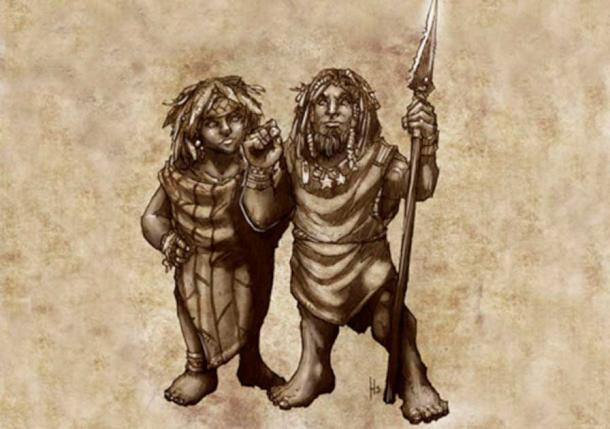
A modern depiction of the Menehune dwarves of Hawaiian mythology. (butterfrog)
The Menehune of Hawaiian Mythology
In Hawaiian mythology, the Menehune are said to be an ancient race of small-stature people who lived in Hawaii before settlers arrived from Polynesia. Many scholars attribute ancient structures found on the Hawaiian Islands to the Menehune. However, others have argued that the legends of the Menehune are a post-European contact mythology and that no such race existed.
The mythology of the Menehune is as old as the beginnings of Polynesian history. When the first Polynesians arrived in Hawaii, they found dams, fish-ponds, roads, and even temples - all said to have been built by the Menehune who were superb craftspeople. Some of these structures still exist and the highly-skilled craftsmanship is evident.
According to legend, each of these mythical creatures was a master of a certain craft and had one special function they accomplished with great precision and expertise. They would set out at dusk to build something in one night, and if this was not achieved, it would be abandoned. To date, no human skeletal remains of a physically small race of people have ever been found on Kaua’I or on any other Hawaiian Islands.
While this does not disprove that a race of small people existed, it does draw the truth behind the legend into question. Nevertheless, there is compelling evidence, both archaeological and in the numerous legends passed down over generations, that suggests that there was indeed an ancient race of highly-skilled people who inhabited the Hawaiian islands long before the Polynesians arrived.
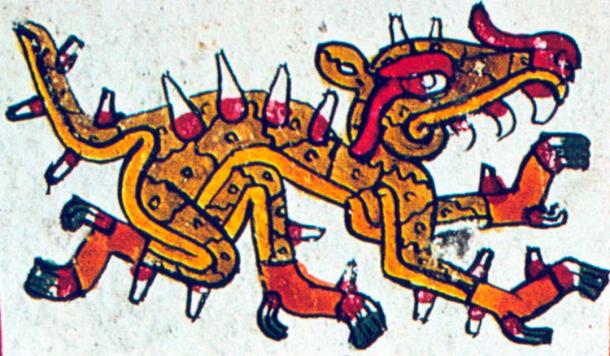
Cipactli is one of the mythical creatures from Aztec legends. (Public domain)
Cipactli, the Aztec Creator with an Insatiable Appetite
The Aztecs of Mexico held the belief that the Earth was created from the destruction of a large sea demon, created by and known to the gods as Cipactli. Cipactli was described in many fashions: a crocodile with toad and fish characteristics, a sea demon, or a monster. Regardless of the description, the Aztecs considered this asexual sea being as the source of the cosmos.
Cipactli’s appetite was insatiable and each joint of the mythical creature bore a mouth. As the gods began the process of creation, they soon realized that their other creations would fall into the void and be devoured by the demon, so they decided to destroy Cipactli. Tezcatlipoca lured the monster in and lost a foot to its insatiable appetite before the gods were able to defeat it.
- 7 Legendary Cryptids that Turned Out to Be Real!
- Godlike Power and Monster Malevolence: Mishipizheu of Lake Superior
Cipactli put up a fight, but in the end the gods prevailed. They pulled Cipactli’s body in four directions and freed the universe from it. Then Tezcatlipoca and Quetzalcoatl created the heavens and the Earth and everything therein from Cipactli’s body. The creature’s head became the thirteen heavens, its tail the underworld, and its midsection the Earth.
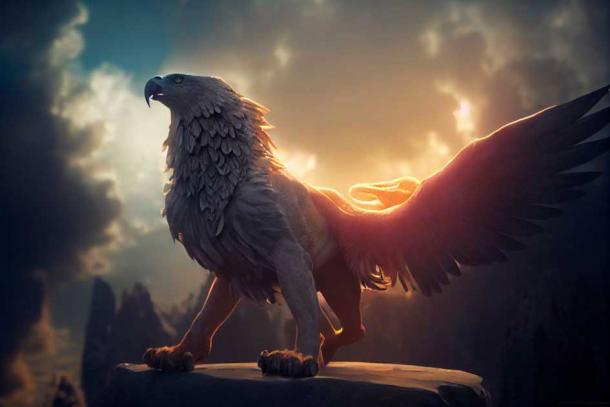
Griffins are ancient mythical creatures with the head and wings of an eagle and the body of a lion. (Declan Hillman / Adobe Stock)
The Majestic Griffin
The griffin is a legendary mythical creature with the head and wings of an eagle, and the body, tail, and hind legs of a lion. As the eagle was considered the king of the birds, and the lion the ‘king of the beasts’, the griffin was perceived as a powerful and majestic creature.
During the Persian Empire, the griffin was seen as a protector from evil, witchcraft, and slander. While griffins are most common in the art and mythology of ancient Greece, there is evidence of representations of griffins in ancient Persia and ancient Egypt dating back to as early as the 4th millennium BC. On the island of Crete in Greece, archaeologists have uncovered depictions of griffins in frescoes in the Throne Room of the Bronze Age Palace of Knossos dating back to the 15th century BC.
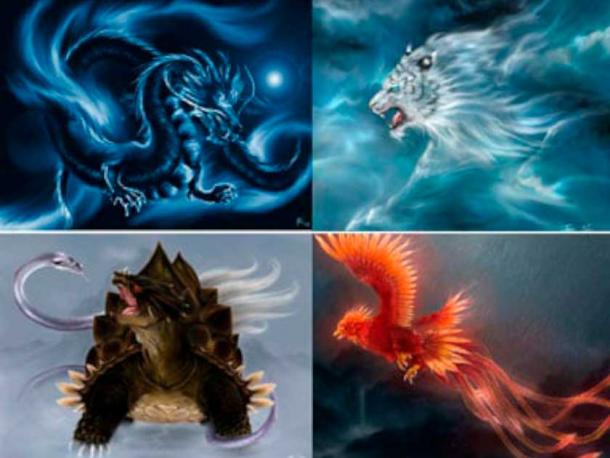
The four mythical creatures of China; the Azure Dragon of the East, the White Tiger of the West, the Black Tortoise of the North, and the Vermillion Bird of the South. (Author provided)
The Four Mythical Creatures of China
In ancient Chinese astronomy, the sky ecliptic was divided into four sections. Each of these sections contained seven mansions, and together they formed the 28 Mansions. The 28 Mansions may be considered to be equivalent to the zodiacal constellations in Western astronomy, although they reflect the movement of the Moon through a sidereal month rather than the Sun in a tropical year.
This enabled the ancient Chinese to mark the traveling positions of the Sun and the Moon, as well as to determine the time and seasons. Each section of the sky is assigned to a mythical creature, collectively known as the Four Symbols. These mythical creatures are the Azure Dragon of the East, the White Tiger of the West, the Black Tortoise of the North, and the Vermillion Bird of the South. Apart from their astronomical significance, each of the Four Symbols is surrounded by various mythological associations.
Top image: Mythical creatures from around the world include the legendary Griffin shown here. Source: ShiaoHuai / Adobe Stock
By Joanna Gillan
















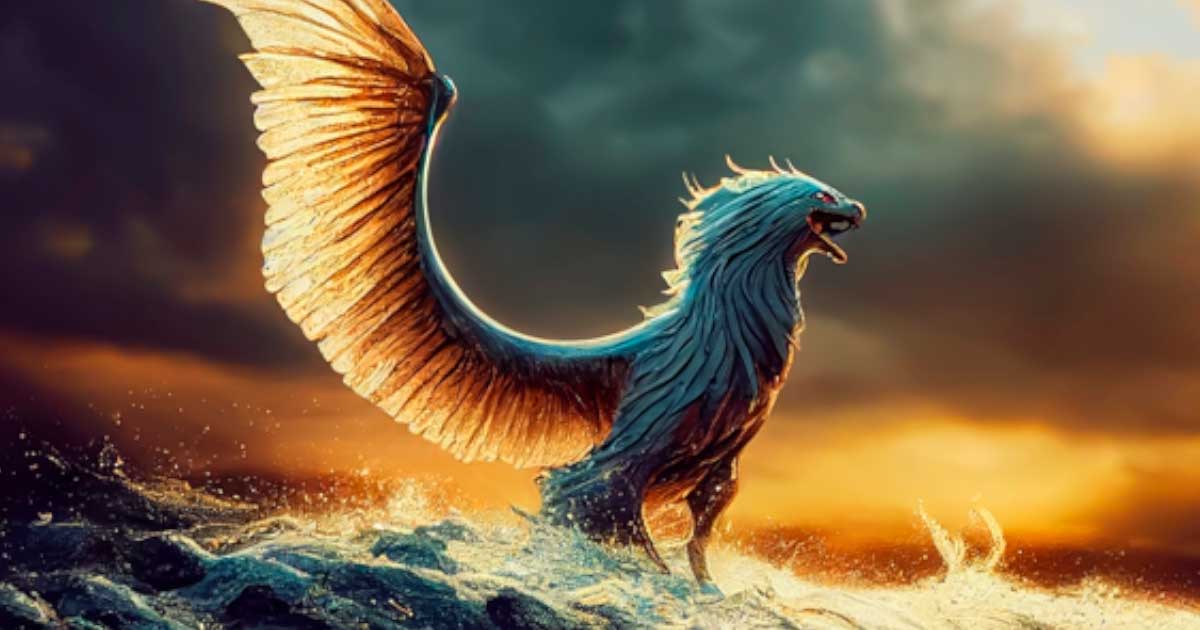

Comments
Considering the dinosaurs, and what may have still existed 5,000, 10,000 years ago it is possibility that some of those creatures are not so mythical. And when you look at the size of some of the sea creatures today in the deepest parts of the ocean the kraken may just really have been a giant octopus.
Antediluvian genetic vrossings were common.. it was one of the massive wickedness' that prevailed.. so i choose to believe among other things that "as in the days of noah" could very well to refer to this practice.. the duck billed playtpus ,the manx cat among others these are obvious crossspecies breeds.. with the chinese making ape human hybrids, the japanese investing in niko girls, and underground cloning(not unethical in its sense but banning it only drives it into the dark, which will be unethical) ... In anycase, my point being that these creatures could actually have exististed considering there are cross species chimaeras just from intercourse(litiglons, mules, aforementioned manx cats, etc(theres a website desribing every documented cross species incident, including multiple examples of human animal thru intercourse over the years)... so u see where im going with this... The kali age, age of the iron toothed beast, is in gull swing.. enjoy the ride..
infinitesimal waveparticles comprise what we call home the earth
manipulatable by thought ability supressed in humans since birth
April, those are Ten marvelous, breathtaking, awe-inspiring, magnificent, wonderful, jaw-dropping, amazing, impressive, excellent, and mind-blowing Images of me. Children, be afraid. Be very afraid. Listen to your parents.
Or else!
Mishkan 1.2m below Heel Stone
@ Stonehenge, United Kingdom
not to mention it's an unauthorized reuse of Magic the Gathering card art
Just want to point out that you have the picture of a immensly large Hydra pictured under the Naga headline. Naga is humanoid with a snakes lower body, right?